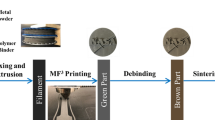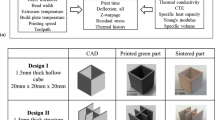Abstract
Amongst the low-cost additive manufacturing processes available, fused filament fabrication (FFF) is one of the most widely used configurations not only for prototypes but also for functional components. Despite such extensive uptake, there are few comprehensive numerical tools available to aid in the design and structural optimization of components obtained with this technology. To address this shortfall, the present work embraces a methodology for thermal and structural simulation of the filament deposition process, with particular emphasis on the influence of process parameters and deposition strategy on the resulting residual stresses and distorsion to allow optimization of outcomes in terms of structural integrity and build accuracy. The developed finite elements simulation considers both material properties and process parameters, as well as environmental conditions. Comparison between simulation outcomes, thermal measurements and optical profiler acquisitions confirms good alignment, suggesting that such an approach is likely to prove valuable in improving process outcomes.
Similar content being viewed by others
Abbreviations
- ρ :
-
Material density
- c p :
-
Specific heat capacity
- λ :
-
Thermal conductivity
- h :
-
Convective coefficient
- ϵ :
-
Emissivity
- T extr :
-
Extrusion temperature
- T p :
-
Building plate temperature
- T c :
-
Printing chamber temperature
References
C. S. Lee et al., Measurement of anisotropic compressive strength of rapid prototyping parts, J. Mater Process Technol., 187–188 (2007) 627–630.
W. Wu et al., Influence of layer thickness and raster angle on the mechanical properties of 3D-printed PEEK and a comparative mechanical study between PEEK and ABS, Materials, 8 (2015) 5834–5846.
S. H. Ahn et al., Anisotropic material properties of fused deposition modeling ABS, Rapid Prototyp J, 8(4) (2002) 248–257.
C. Ziemian et al., Anisotropic mechanical properties of ABS parts fabricated by fused deposition modelling, Mechanical Engineering, InTechOpen, London (2012).
C. Ursini and L. Collini, FDM layering deposition effects on mechanical response of TPU lattice structures, Materials, 14(19) (2021) 5645.
A. Corvi et al., Analysis and modelling of damage mechanism in FDM 3D-printed lattice structure under compression loading, J. Mech. Sci. Technol., 37(3) (2023) 1089–1095.
B. Brenken et al., Development of a model to predict temperature history and crystallization behavior of 3D-printed parts made from fiber-reinforced thermoplastic polymers, Proceedings of SAMPE 2016, Long Beach, USA (2016) 23–26.
B. Brenken et al., Development and validation of extrusion deposition additive manufacturing process simulations, Addit. Manuf., 25 (2019) 218–226.
E. Barocio et al., Prediction of the degree of bonding in the extrusion deposition additive manufacturing process of semicrystalline polymer composites, Science in the Age of Experience (2018) 18–21.
N. An et al., Implementation of Abaqus user subroutines and plugin for thermal analysis of powder-bed electron-beam-melting additive manufacturing process, Mater. Today Commun., 27 (2021) 102307.
A. Cattenone et al., Finite element analysis of additive manufacturing based on fused deposition modeling: distortions prediction and comparison with experimental data, J. Manuf. Sci. Eng., 141 (2019).
H. R. Vanaei et al., In-process monitoring of temperature evolution during fused filament fabrication: a journey from numerical to experimental approaches, Thermo., 1 (2021) 332–360.
H. R. Vanaei et al., Numerical prediction for temperature profile of parts manufactured using fused filament fabrication, J Manuf Process, 76 (2022) 548–558.
H. Prajapati et al., Measurement and modeling of filament temperature distribution in the standoff gap between nozzle and bed in polymer-based additive manufacturing, Addit. Manuf., 24 (2018) 224–231.
Author information
Authors and Affiliations
Corresponding author
Additional information
Alberto Corvi is a Ph.D. student in the University of Parma, Parma, Italy. His research interests include Additive Manufacturing, Metamaterials, Numerical Modelling and Computational Mechanics.
Rights and permissions
About this article
Cite this article
Corvi, A., Collini, L., Sciancalepore, C. et al. Influence of process parameters on temperature field and residual strain in FFF-printed parts. J Mech Sci Technol 37, 5521–5527 (2023). https://doi.org/10.1007/s12206-023-2302-8
Received:
Revised:
Accepted:
Published:
Issue Date:
DOI: https://doi.org/10.1007/s12206-023-2302-8




